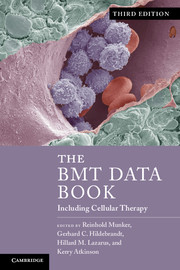Book contents
- Frontmatter
- Contents
- List of contributors
- Foreword
- Preface
- Acknowledgments
- Section 1 Basic science
- Section 2 Hematologic malignancies
- Section 3 Solid tumors
- Section 4 Nonmalignant disorders
- Section 5 Cellular therapy
- Section 6 Practical aspects and procedures
- Section 7 Complications
- Section 8 The BMT/SCT pharmacopoeia
- Section 9 HLA-testing and laboratory medicine
- Appendix Guide to the internet and literature databases relevant for BMT/SCT
- Index
Foreword
Published online by Cambridge University Press: 05 August 2013
- Frontmatter
- Contents
- List of contributors
- Foreword
- Preface
- Acknowledgments
- Section 1 Basic science
- Section 2 Hematologic malignancies
- Section 3 Solid tumors
- Section 4 Nonmalignant disorders
- Section 5 Cellular therapy
- Section 6 Practical aspects and procedures
- Section 7 Complications
- Section 8 The BMT/SCT pharmacopoeia
- Section 9 HLA-testing and laboratory medicine
- Appendix Guide to the internet and literature databases relevant for BMT/SCT
- Index
Summary
It is over 50 years since the basic concepts underpinning bone marrow transplantation were revealed in radiation protection experiments in mice. It seems curious now that in the 1950s the idea that marrow cells could grow and reconstitute hematopoiesis in an irradiated recipient was so revolutionary that it took a series of critical experiments to prove the “cellular theory” and disprove the “humoral theory” of radiation protection. Equally remarkable is the fact that within a few years (and at a time when our knowledge of lymphocytes was sketchy) the unique allotransplant-associated phenomena of graft-versus-host disease, graft rejection, and graft-versus-leukemia effects were teased out, paving the way for human transplant studies in the 1960s.
Fast forward to today, bone marrow transplantation has become stem cell transplantation (SCT), incorporating the use of umbilical cord and peripheral blood as stem cell sources. The complexity of the field has increased exponentially as transplant biology is defined increasingly at the molecular level. SCT or HCT (hematopoietic cell transplantation) is continually being extended to new malignant and nonmalignant diseases and is increasingly used because more unrelated donors and cord blood donations are available, and mismatched transplants can be performed more safely. Currently, over 25 000 SCTs are performed annually in over 70 countries. As confidence to deliver transplants with low mortality has grown, SCTs are being applied increasingly to older patients. Luckily, expertise in the clinical transplant community has kept pace with this expansion. There has been an overall increase in transplant “know how” and many procedures and approaches are standardized worldwide. To maintain our standards of care at the cutting edge, clinicians need a reference volume for the many algorithms of treatment we now handle in treating our patients. The editors of The BMT Data Book, Drs Munker, Hildebrandt, Lazarus, and Atkinson, have striven to produce a book that fulfills the stem cell transplanter’s need for a practical guide and data source. Particularly, attention has been given to the practical issues of who should have a transplant and what type of transplant approach should be chosen.
- Type
- Chapter
- Information
- The BMT Data BookIncluding Cellular Therapy, pp. xPublisher: Cambridge University PressPrint publication year: 2013



